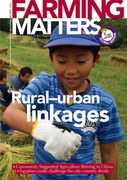Pablo Tittonell argues that it is high time we rethought the role of farms that straddle the rural–urban continuum. Peri-urban farming contributes to food security, buffers shocks and maintains agrobiodiversity.
Only recently I realised that when I was a child, my grandfather was practicing a form of urban agriculture in our backyard in the outskirts of Buenos Aires. But he didn’t see it as such. In his eyes, he was simply producing vegetables for the family, just as his father had done in the Piedmont of the Italian Alps before migrating to Argentina. Most people around us were doing the same thing too.
After all, our neighbourhood had been a green belt of commercial vegetable production only a few decades ago. During this transition, we lived in an open landscape with some relics of wilderness on the low productivity soils, marshes or river margins, and new signs of urbanisation – infrastructure, public transport, schools, parks and shops. I have to think about this mosaic every time I hear about projects for ‘new green cities’ in Europe, such as the projected green city of Almere, The Netherlands.
It also reminds me of other places. When I first visited Vihiga district in western Kenya, back in 2002, the population density was already incredibly high, with up to 1000 people living in every square kilometre. With the average family of about five cultivating less than half a hectare, about 60% of households earned part or most of their income from work outside the farm. Life would not have been possible without a fluid and strong rural–urban connectivity. Family members living in the cities would send money to their rural ’homes’. And especially in times of economic crises, rural families sent food to assist those in urban areas. Revisiting the area in 2012 we found a growing importance of rural–urban connectivity in the area, becoming even stronger with the spread of mobile phones. One example is the fantastic M-Farm initiative, connecting smallholders to urban markets using mobile phone technologies.
Smallholder farming in these peri-urban regions is being privately subsidised through cash remittances and off-farm activities. Which is logical. You can’t make a living from half a hectare of maize even if you get the best yields ever! The phenomenon of rural urban connectivity and interdependence is not only restricted to densely populated regions. For example, similar patterns exist in sparsely populated regions of rural Zimbabwe as described by Andersson.
Perhaps it is time to rethink the role of these farms that straddle the rural–urban continuum. Peri-urban farming is fading as a livelihood option, but not as a source of traditional and diverse food which is not always found on the market. The produce can buffer shocks in times of scarcity, contribute substantially to both rural and urban diets, provide ecosystem services and maintain agrobiodiversity.
This was true back in the 1970s in my grandfather’s garden and it is true for Vihiga today, and could become true in the future green cities of Europe. Perhaps it can be an alternative to the current research and development approach to food security, which continues to push the narrow idea that increasing yields of staple food crops is the primary solution.
Pablo Tittonell
Pablo Tittonell is Professor of the Farming Systems Ecology group at Wageningen University and Research Centre, the Netherlands. He is a board member of the African Conservation Tillage network and the European focal point of the Latin American Scientific Society on Agroecology (SOCLA). He is our regular columnist for 2015.
Email: pablo.tittonell@wur.nl


